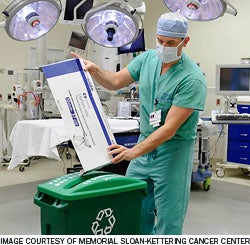Sustainability delivers big savings for hospitals
 Hospitals committed to sustainability increased their savings substantially in 2011 compared to the previous year, largely by expanding tried-and-true conservation actions that cut waste and use of resources.
Hospitals committed to sustainability increased their savings substantially in 2011 compared to the previous year, largely by expanding tried-and-true conservation actions that cut waste and use of resources.
The 2012 Sustainability Benchmark Report recently released by Practice Greenhealth, Reston, Va., shows that the 149 hospitals that qualified as the organization's 2012 Environmental Excellence Award winners saved a combined $55 million in 2011 by cutting waste in several operational areas.
That's a 22 percent increase compared with the $43 million in savings achieved by the 2011 award winners in 2010, says Lin Hill, director of awards, Practice Greenhealth. The three levels of award winners depend on their sustainability achievements.
The report includes data and analysis on hospital practices in many areas, including waste stream reduction, energy efficiency, green cleaning, water use and green building.
Laura Wenger, R.N., executive director, Practice Greenhealth, says the report shows that more hospitals are pursuing sustainability.
"As more research comes out and opportunities increase, more health care facilities are becoming aware of sustainability's benefits," she says.
Seema Wadhwa, director of the Healthier Hospitals Initiative, Reston, Va., and also director of sustainability for Inova Health System, Falls Church, Va., views the report as a sign that hospitals continue to see sustainability as a cost-saving opportunity.
"If you waste less, you save more. Where people used to think that going green would cost them more, they're actually starting to see [that] there is a business case for it," says Wadhwa.
Of the $55 million in waste reductions achieved by the hospitals analyzed, about $49 million was derived through single-use device (SUD) reprocessing, recycling and electric power reduction.
The $18.3 million in savings through SUD reprocessing was the most in any single category, and represents a 35 percent increase from the $11.8 million saved in 2010, says Hill. Pulse oximeters, compression sleeves and catheters were the most commonly reprocessed devices.
"The nice thing about reprocessing is that it's applicable to every organization whether you're small or large," says Wadhwa.
The report states that hospitals saved $16.8 million by recycling, the second largest amount of all waste-reduction categories in the report.
Wadhwa says recycling is expanding because more health care facilities are engaging in sustainability, and the waste management industry is making it easier to recycle on the front end because automated technology separates commingled waste,
she says.
Energy-efficiency measures to cut the use of electricity resulted in $14.3 million in savings, the report shows. Typical measures include installing variable-frequency drives, lighting upgrades and the installation of occupancy sensors, notes Hill.
Because energy costs typically represent about 1 to 3 percent of a hospital's operating costs, they frequently have been overlooked as a source of financial savings in the past, says Wadhwa.
That is changing as hospitals recognize that benefits are attainable without major capital investments, says Wenger. Water conservation is gaining attention, with $1.3 million saved through actions such as cooling tower optimization, the use of low-flow faucets and toilets, and gray water irrigation, says Hill.
For information on obtaining the full report, go to www.practicegreenhealth.org.




